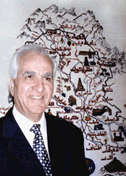The Swimming Hijab
A Way For Muslim Women To Enjoy Family Holidays By The Sea?
Muslim women living in the 21st century are faced with a dilemma: do they comply with Islamic dictates and values or do they free themselves, to a lesser or greater extent, from the constraints these dictates impose. This situation is highlighted and becomes pronounced during summer holidays, when families go the seaside for rest and recreation. Women, and even male members of their family, are under psychological stress: some take pleasure in refreshing the body while bathing on mixed beaches or swimming pools while others are wrapped in their hijab, sweating and regreting the rules which are imposed on them by Islamic traditions. Families are finding it increasingly difficult to convince their daughters to wear the hijab and forsake swimming, especially when the children are taken to the seaside. The hijab on the dry landIt is obvious that Muslim woman must wear the hijab. The interpretation of this obligation varies between shutting women out so they remain house bound, or restricted to the family circle and female circles which are starting to narrow in contemporary society due to the new trends of civilization. Consequently, many social leisure opportunities for women who intend to observe Islamic values, and wear the hijab, have disappeared. Some then start to release themselves from these obligations to varying degrees. It is not just a question of fashion: they believe that the hijab is an obstacle to their progress in different fields. In this article, we do not affirm categorically that there are two groups: respectful women who follow Islamic rules regarding hijab, and women without hijab but respectful of the Islamic obligations of modesty in their clothing and behavior. The phenomenon of the spread of hijab, following the Islamic awakening embracing various continents, involved the development of a large variety of models of hijab reconciling the Islamic requirements with the human capacities of creativity and adaptation to the evolution of civilization. Thus, an economic sector developed, allowing many people to live off its products, such as the model makers, the producers, the distributors, the advertisers and the editors. The fashion of hijab started to conquer markets and was sought after, in particular, by young girls. The photographs of the modes of hijab occupied the front pages of magazines, newspapers, as well as television screens. There are even one or more specialized magazines bearing the name 'hijab'. Thus, hijab has gained an aesthetic position showing the Islamic behaviour of high values and humanitarian ethics, which evolved in accordance with contemporary civilizations. The hijab will be the alternative to the dissolution of manners to which civilization was lowered. This has been denounced by respectful woman of human manners, as well as men, world wide, regardless of age or belief. By a strange coincidence, on September 18, 2006, while going to my office, I heard on the radio that it was fashion week in Europe (London, Paris, Milan…). People in responsible positions raised their voices in these countries requiring the prohibition of the exposure of underwear. Others called for greater decency in the fashion parades. Admittedly, all the countries and those in government work to educate women through schools and universities, so they contribute to the development of their societies, side by side with men. They provide them with a culture which does not separate women and men from the respect of their values and traditions, as well as general human manners. My approach to the subject of hijab is that of global Islam where each city around the world shelters some of its followers, and not of the Islam isolated in certain cities or villages. I wonder how the obstacles impeding veiled women from realising their full potential in all fields: cultural, scientific, economic, social, and leisure in accordance with Islamic values, be removed? Fatwas of the JuristsOur request is addressed particularly to the foqahas (Muslim theologists) of all the Islamic doctrines, so that they exert every possible effort to find solutions suitable to our time, on the basis of Sharia’a which is stated in the Koran and Hadiths (traditions) of our Prophet. We know that the divine rules were limited in their categorical judgements, and that the foqahas work through ijtihad (interpretation) to adapt them to the new aspects of the question. There are divergences between doctrines, and foqahas of the same doctrines. Even during the lifetime of the same faqih, it is essential to have a contemporary opinion about the types of hijab, its need and limits of its observation. Women wearing the hijab in various societies will thus have the legal backing to wear it as the fatwas stipulate it is suitable. This is the minimum duty required of the foqahas. They should deliver an opinion adapted to our time taking into account God’s equal treatment of men and women in rewards and punishment- except in certain financial rights. But one should not confuse the opinion of Sharia’a and that of social convention which varies from one society to another. Beaches for womenIt is imperative to provide private beach for women, to create female sporting clubs, including swimming and leisure clubs, or to reserve time, even on mixed beaches where women are admitted in the programs of the present mixed clubs. The needs of observant Muslim women throughout the world must be catered for. The swimming hijabThe swimming hijab that I discovered during my last visit to Egypt is a suitable solution to make it possible for a woman to swim with members of her family in mixed beaches and swimming pools. I observed on Al Mountazah beach in Alexandria, where I spent a few days with my family, a concrete example of what observant women of various ages endured while trying to swim in their clothes. I also found there many other muhajabas women sitting at the edge of the beaches with their beautiful luxurious clothes. The beaches were so crowded that there were six lines of tables for seated people and hundreds of people in the water. I contemplated this spontaneous popular phenomenon and compared it to other beaches in different countries, especially Casablanca (Morocco) where the image of its natural beaches and beautiful swimming pools is still alive in my memory. I also remembered other beaches I had seen on my travels and thought of these women who want to respect their beliefs and Islamic manners without depriving themselves of the legitimate pleasures of life. I found the premises of the solution when I saw the swimming hijab, known as the 'legal swim suit' created recently in Egypt. In my opinion, this at last answers all the requirements of the hijab. It is manufactured from industrial fibres which prevent it from sticking to the skin when wet, and thus not showing the contours of the woman's body as she comes out of the water. I believe that technological developments, which are a gift from God, contributed to the resolution of the question of the participation of women swimming with members of their families. Lastly, I must confess that the swiming hijab is the most difficult subject I have ever tackled. During the past two months this subject caused me considerable anguish. I looked at its various aspects, in particular the theological issues, without being a theologian, and political without being a politician. Because hijab assumed a political connotation it was prohibited and challenged in several countries, including Islamic countries. Will the extension of the legal shirt to the beaches of the world alleviate the pressure on veiled women, or will it worsen their suffering? Will it convince those who disparage Islam and claim it is not a religion of civilization, love and beauty, applicable to all times and the places? Everyone is invited to bring the fruits of his/her thoughts on this question for the good of Islam and humanity and I look forward to readers comments. May God guides us to success
http://news.bbc.co.uk/1/hi/programmes/fast_track/8901976.stm
|

